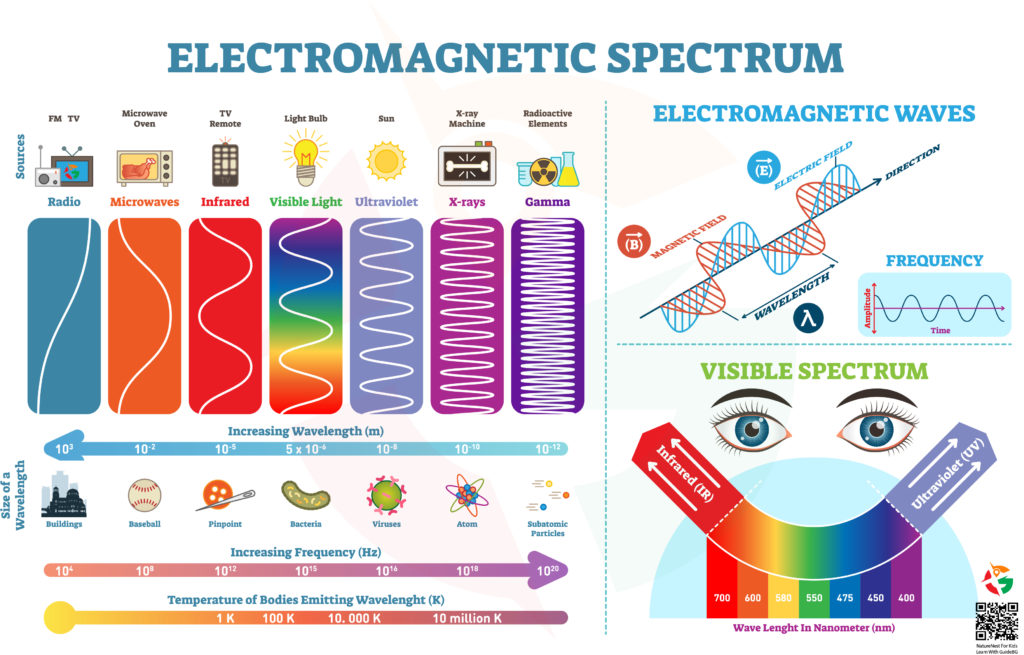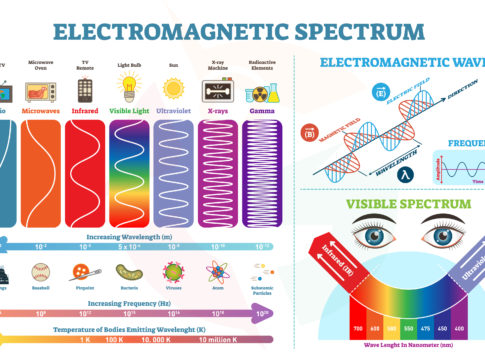Welcome, young explorers, to an electrifying journey into electromagnetic waves! Imagine invisible lines of energy zooming around you, carrying messages, colors, and even the sun’s warmth. These aren’t just any waves; they’re the universe’s superheroes, capable of traveling through the vacuum of space itself! Let’s dive into their world and discover what makes them tick.
What Are Electromagnetic Waves?
Electromagnetic waves are like the universe’s delivery system, sending energy across space at the speed of light. They’re made up of magnetic (B) and electric (E) fields vibrating at certain angles, creating a forward wave. Think of them as invisible ripples spreading out from a stone thrown into a pond, but these ripples can move through the emptiness of space! Compare electromagnetic to sound waves.
Wave Length and the Spectrum
Wavelength is the distance between one wave peak and the next, measured in meters. But electromagnetic waves can vary hugely in size, from buildings down to subatomic particles. As we move through the types of waves, from radio waves to gamma rays, the wavelength gets shorter, which means the frequency (how often the waves pass a point in a specific time) gets higher.

The Electromagnetic Spectrum: A Rainbow of Waves
- Radio Waves: These are the giants of the wave world, with wavelengths as long as buildings or as small as a baseball. Imagine throwing a ball as far as you can; that’s how radio waves travel, carrying your favorite songs and shows to your radio or TV.
- Microwaves: Smaller than radio waves, microwaves are about the size of a baseball or a pinpoint. They’re the speedy chefs in your microwave oven, heating your snacks by making water molecules dance.
- Infrared: Just a bit tinier, with wavelengths the size of a pinpoint to the width of a hair. Infrared waves are like the universe’s warm hugs, bringing us heat from the Sun and working on your TV remote.
- Visible Light: This is where the magic happens, with wavelengths in nanometers (nm), tiny enough to fit between infrared and ultraviolet. Visible light paints the world in colors, from red to violet, allowing us to see the beauty around us.
- Ultraviolet: These waves are even smaller, like bacteria and viruses. They’re the invisible warriors that give you a suntan but also remind you to wear sunscreen to protect your skin.
- X-rays: With wavelengths as small as viruses to atoms, X-rays are the superheroes that see through your skin, helping doctors examine your bones! Learn about the types of human bones and their structures.
- Gamma Rays: The smallest and mightiest, with wavelengths the size of atoms to subatomic particles. Gamma rays come from the most explosive events in the universe, like supernovas.
Frequency and Amplitude: The Wave’s Power
As the waves get smaller, their frequency increases, meaning they vibrate faster. This is like comparing the beats of a drum: fast beats for gamma rays and slow beats for radio waves. The amplitude, or height of the wave, tells us how much energy it carries. Higher amplitude means more power, like a louder sound or a brighter light.
Temperature and Colors: The Heat of the Waves
Every type of electromagnetic wave is associated with a different temperature, measured in Kelvin. Higher frequencies, like gamma rays, come from the hottest sources, while lower frequencies, like radio waves, come from objects with lower temperatures. This is why the Sun, with its scorching temperature, emits a wide range of waves, including the visible light that bathes our planet in colors.
The Colors of Visible Light
Visible light is the part of the spectrum we can see, with each color corresponding to a different wavelength:
- Red: Around 700 nm
- Orange: About 620-590 nm
- Yellow: Roughly 590-570 nm
- Green: Approximately 570-495 nm
- Blue: Close to 495-450 nm
- Violet: Around 450-400 nm
Each light color has its unique wavelength, painting the world in a rainbow of colors. From the warm reds of a sunset to the cool blues of a clear sky, visible light brings the universe to life.
Wave Sources and Their Secrets
Electromagnetic waves are produced by various sources, depending on their type. Radio waves come from antennas, microwaves from microwave ovens, and visible light from the Sun and other stars. Each type of wave carries information and energy across the cosmos, interacting with matter in fascinating ways.
Let’s continue this electrifying journey and dive deeper into how these waves shape our understanding of the universe. Keep your curiosity charged, and get ready to uncover more secrets of the electromagnetic spectrum!



